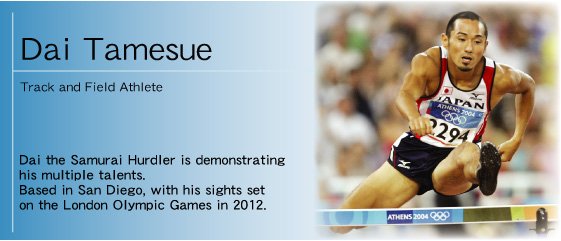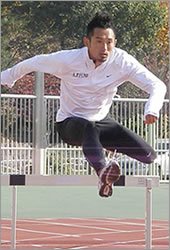YuYu Interview Dai Tamesue
 |
|
Dai Tamesue is the first Japanese athlete to win two medals in the men’s 400m hurdles at the IAAF World Championships in Athletics. 
After moving to San Diego, Tamesue in training, setting his sights on the London Olympic Games in 2012.
A former American track and field athlete recommended San Diego to me. I wanted to live outside Japan and was attracted to the unique character of Americans. I visited cities on the West coast, from Portland to San Diego, and decided that San Diego would be the best environment for me. San Diego has good weather and high-end facilities for track and field. There are a lot of beaches and lawns, so I can run on soft surfaces as a tune-up. I’m doing my training here and setting my sights on the 2012 Olympic Games in London. —— What was your father like? He was just an ordinary person. Not particularly a fast runner and he always wondered why his son had become a track and field athlete. When I was twenty-five he passed away rather suddenly. By the time he was diagnosed with larynx cancer, it was too late. He died six months after the diagnosis. He was only fifty-four. His death made me think that humans cannot decide for themselves when to be born or die. “All I can do is to live my life now for all it’s worth,” I said to myself. —— What’s your attraction to track and field? What are the characteristics of the 400m hurdles? Track and field is the sport where we can confirm the development of humanity in the most theoretical sense.The defining characteristic of hurdling is that you can apply your strategies to the competitions. You can’t win by just running without a strategy. When I was watching the World Junior Championships of Athletics at age 18, I had a flash of inspiration. I thought I could win the hurdles. Quick reactions are all that matters. Instinctively, I knew techniques could cover my shortcomings in physical strength and athletic ability. 
Japan’s Dai Tamesue (L), who finished third in the men’s 400 meters hurdles, poses for picture with Felix Sanchez (C) of the Dominican Republic, the winner of the race, and Italy’s Fabrizio Mori, who came in second (at the World Track and Field Championships at Commonwealth Stadium in Edmonton on Aug. 10, 2001) © kyodo
The advantage of having a coach is to have “a third eye.” The disadvantage is the tendency to rely on him or her when it comes to decision-making.How can you look at yourself objectively, without being swayed by desires or emotions?I believe that’s the key to self-coaching.I’m on my own without a coach in San Diego as well. —— Do you have any unforgettable experiences to share with us? Sure. It was the situation I faced at the 2000 Japan Championships in Athletics -- there were only 1,000 people in the audience. Track and field is not a team sport.I guess it doesn’t match the typical way of watching sports in Japan -- that is, to support a team. The essence of track and field is found in the beauty of the competing athletes and the challenge of expanding beyond their previous limitations. We must spread the word about the beauty of track and field. —— What are you doing to promote track and field and make it more popular? 
The multi-talented hurdler has published a book on investment. "Track and field and investment have something in common. For both, it's important to take into account the next generation."
What are the similarities between the different worlds of being an athlete and an investor? They are similar in the sense that for both there are always opportunities moving against the general trends. When everyone is buying something—don’t buy it; when everyone isn’t buying it—buy it. When everyone is doing something—don’t do it; when everyone isn’t doing it—do it. Whenever you act differently from others, taking into account the next generation, people may consider you eccentric. That is what track and field and investing have in common. —— Was there a turning point in your life? When did it come? It came when I decided to become a professional athlete to live my own life. I resigned from Osaka Gas in 2003 and became a pro as a member of the Asia Partnership Fund (APF) in 2004. On his deathbed, my father said to me, “Do what you want.” That motivated me to pursue a career as a pro. —— What are the advantages and disadvantages of being a pro? Unlike employee athletes who compete for their companies, a professional athlete can concentrate on track and field. You can sign a contract for a commercial. You can act for the benefit of yourself and the organization you belong to.You have freedom, both physically and mentally. On the other hand, a pro doesn’t have a stable income while employee athletes get salaries.As a pro, you have to cover your expenses out of your own pocket. Your income varies depending on how the public evaluates you and your popularity. Moreover, a prolonged injury can be fatal to your career as an active athlete. —— Why did you write “The Investment Hurdler: How the Initial Investment of 300K Yen Grew to 20M Yen”? Being a track and field athlete means your income completely depends on your performance and it’s not a lucrative career. So I thought I needed another source of income independent from athletics. I’m as serious about investment as I am about track and field. I wrote the book because I wanted to tell people what the “right investment” and “good investments” are. I wrote this book first because I can write a book on track and field anytime after I retire. —— Can you tell us about your official website, “Samurai Hurdler”? I’m writing a blog on this site. It’s a convenient tool for me to let people know what I think, theories about running, etc.I write about a variety of topics, including politics and the economy. The image of my life as an athlete has been called strong, hard-core and intense, but I want to explore the softer side of it. —— Can you tell us about the cross-cultural experiences or life lessons you have experienced outside of Japan? I was introduced to a person in the Netherlands. I thought his name was “Nephew” for quite a while. After coming to San Diego, I found out it wasn’t his name, he was really someone’s nephew. There’s room for my English to improve. (Laughter)My impression of America is that there’s a strong sense of justice, people are good at negotiating, and they’re not jealous of those who are extraordinary. Renting a house and buying a car taught me a lot about the importance of negotiation. —— What’s your motto? ”People make mistakes.”This was the lesson I learned when I didn’t perform how I wanted at the World Championships in Athletics in Osaka two years ago.Even investment experts have failed to correctly predict the economic trends over the last year. No matter how experienced you are in a particular field, it is impossible for him or her to know everything. The box of gun powder used for track and field races has a line that reads, “You are safe if you know the danger.”I like this line. 
Tamesue (second from left in the first row) was among the athletes who were selected to compete at the 11th IAAF World Championships in Athletics in Osaka. (Kita-ku, Osaka, July 2, 2007)
I am training with the aim of competing in the Olympic Games in London, so that is a major goal of mine. As for future projects, I would like to found a school for Asian children and provide them with a system of teaching sports after I retire as an athlete. It’s my dream to establish a major sports academy based in Asia. (07-16-2009 issue) |

